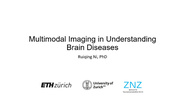Collection:

The advances in neuroimaging in the last decades have bridged the translational gap, and enabled our understanding of brain under physiological and disease conditions. Multiscale and multimodal imaging such as positron emission tomography, magnetic resonance imaging, optoacoustic and fluorescence imaging have provide molecular, structural, and functional insights at cellular, circuit and whole brain levels. The use of maging biomarkers has also assisted the early and accurate diagnosis of brain disorders, and facilitated personalized medicine. This webinar will focus on the development of novel brain imaging techniques, as well as their application in the field of Alzheimer?s disease. Multimodal high-resolution imaging tools were developed for non-invasive visualization of the neuropathology (amyloid-beta and tauopathy), brain connectivity, and atrophy in mouse models of Alzheimer?s disease.
- IEEE MemberUS $10.00
- Society MemberUS $0.00
- IEEE Student MemberUS $10.00
- Non-IEEE MemberUS $20.00
Videos in this product
IEEE Brain: Multimodal Imaging in Understanding Brain Diseases
The advances in neuroimaging in the last decades have bridged the translational gap, and enabled our understanding of brain under physiological and disease conditions. Multiscale and multimodal imaging such as positron emission tomography, magnetic resonance imaging, optoacoustic and fluorescence imaging have provide molecular, structural, and functional insights at cellular, circuit and whole brain levels. The use of maging biomarkers has also assisted the early and accurate diagnosis of brain disorders, and facilitated personalized medicine. This webinar will focus on the development of novel brain imaging techniques, as well as their application in the field of Alzheimer?s disease. Multimodal high-resolution imaging tools were developed for non-invasive visualization of the neuropathology (amyloid-beta and tauopathy), brain connectivity, and atrophy in mouse models of Alzheimer?s disease.
 Cart
Cart Create Account
Create Account Sign In
Sign In
